

Personal Care Products with Microbeads are Polluting Water, Illinois Becomes First to Ban. Would you voluntarily rinse microscopic synthetic plastic balls down the drain?
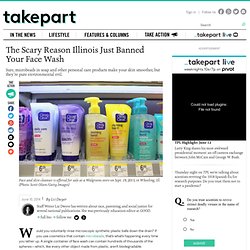
If you use cosmetics that contain microbeads, that’s what’s happening every time you lather up. A single container of face wash can contain hundreds of thousands of the spheres—which, like every other object made from plastic, aren’t biodegradable. Imagine a gazillion tiny plastic balls floating through the world’s streams, rivers, lakes, and oceans, adding to the already insane amount of plastic in the water. Scared? You should be.
S.B. 2727, which was sponsored by state Sen. Over the past decade, face washes and other skin care products have become laden with the beads. “Banning microbeads will help ensure clean waters across Illinois and set an example for our nation to follow,” Illinois Gov. Pressure is mounting on personal care manufacturers to reduce the negative impact of their products on the lakes and the surrounding environment. New York may soon follow Illinois’ lead in banning microbeads. China to spend $330 billion to fight water pollution -paper. Water Pollution Facts, Effects of Water Pollution, Clean Water Act. Air Pollution Facts, Air Pollution Effects, Air Pollution Solutions, Air Pollution Causes. Smog hanging over cities is the most familiar and obvious form of air pollution.
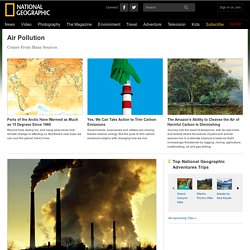
But there are different kinds of pollution—some visible, some invisible—that contribute to global warming. Generally any substance that people introduce into the atmosphere that has damaging effects on living things and the environment is considered air pollution. Carbon dioxide, a greenhouse gas, is the main pollutant that is warming Earth. Though living things emit carbon dioxide when they breathe, carbon dioxide is widely considered to be a pollutant when associated with cars, planes, power plants, and other human activities that involve the burning of fossil fuels such as gasoline and natural gas.
In the past 150 years, such activities have pumped enough carbon dioxide into the atmosphere to raise its levels higher than they have been for hundreds of thousands of years. Kids 4 Clean Air. You need to breathe to stay alive.
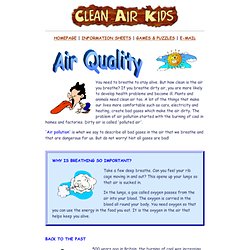
But how clean is the air you breathe? If you breathe dirty air, you are more likely to develop health problems and become ill. Plants and animals need clean air too. A lot of the things that make our lives more comfortable such as cars, electricity and heating, create bad gases which make the air dirty. The problem of air pollution started with the burning of coal in homes and factories. 'Air pollution' is what we say to describe all bad gases in the air that we breathe and that are dangerous for us. 500 years ago in Britain, the burning of coal was increasing in cities like London. Education: Whatcha Doin' About Air Pollution? Water Pollution. Kids - Earth - Pollution. The Crying Indian - full commercial - Keep America Beautiful. Kids - Earth - Fighting pollution by tracking trucks. Reverse Osmosis Water Filter Selection Guide & Reviews. Is your tap water really that bad or are we just being paranoid?

Read on.... Clean water is one of the most important needs of our bodies. It is a sad fact that something as essential to life as clean drinking water can no longer be granted to us. Unsafe water is not just a third world problem. In fact, safe drinking water is even harder to find specially in industrially developed countries such as the U.S. According to research articles and news, most tap and well water in the U.S. now are not safe for drinking due to heavy industrial and environmental pollution. Contaminants range from naturally-occurring minerals to man-made chemicals and by-products. Bottled Water vs Tap Water on 20/20. Is Bottled Water Better Than Tap? It started with Perrier.

Water Pollution Guide. Clean Water : Water Pollution. In a one-inch rainstorm every acre receives 27,000 gallons of water.
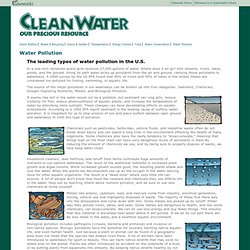
Where does it all go? Into streams, rivers, lakes, ponds, and the ground. Along its path water picks up pollutants from the air and ground, carrying those pollutants to waterways. A 2000 survey by the US EPA found that 40% of rivers and 45% of lakes in the United States are considered too polluted for fishing, swimming, or aquatic life. The source of the major pollutants in our waterways can be broken up into five categories: Sediment, Chemicals, Oxygen Depleting Nutrients, Metals, and Biological Pollution. It seems like dirt in the water would not be a problem, but sediment can clog gills, reduce visibility for fish, reduce photosynthesis of aquatic plants, and increase the temperature of water by absorbing more sunlight.
Chemicals such as pesticides, herbicides, vehicle fluids, and industrial waste often do not break down easily and can spend a long time in the environment effecting the health of many organisms. Water Bottle Pollution. If your family is like many in the United States, unloading the week’s groceries includes hauling a case or two of bottled water into your home.
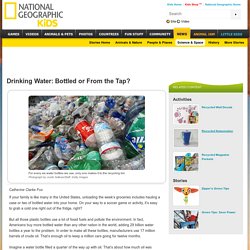
On your way to a soccer game or activity, it’s easy to grab a cold one right out of the fridge, right? But all those plastic bottles use a lot of fossil fuels and pollute the environment. In fact, Americans buy more bottled water than any other nation in the world, adding 29 billion water bottles a year to the problem. In order to make all these bottles, manufacturers use 17 million barrels of crude oil. That’s enough oil to keep a million cars going for twelve months. Imagine a water bottle filled a quarter of the way up with oil. So why don’t more people drink water straight from the kitchen faucet?